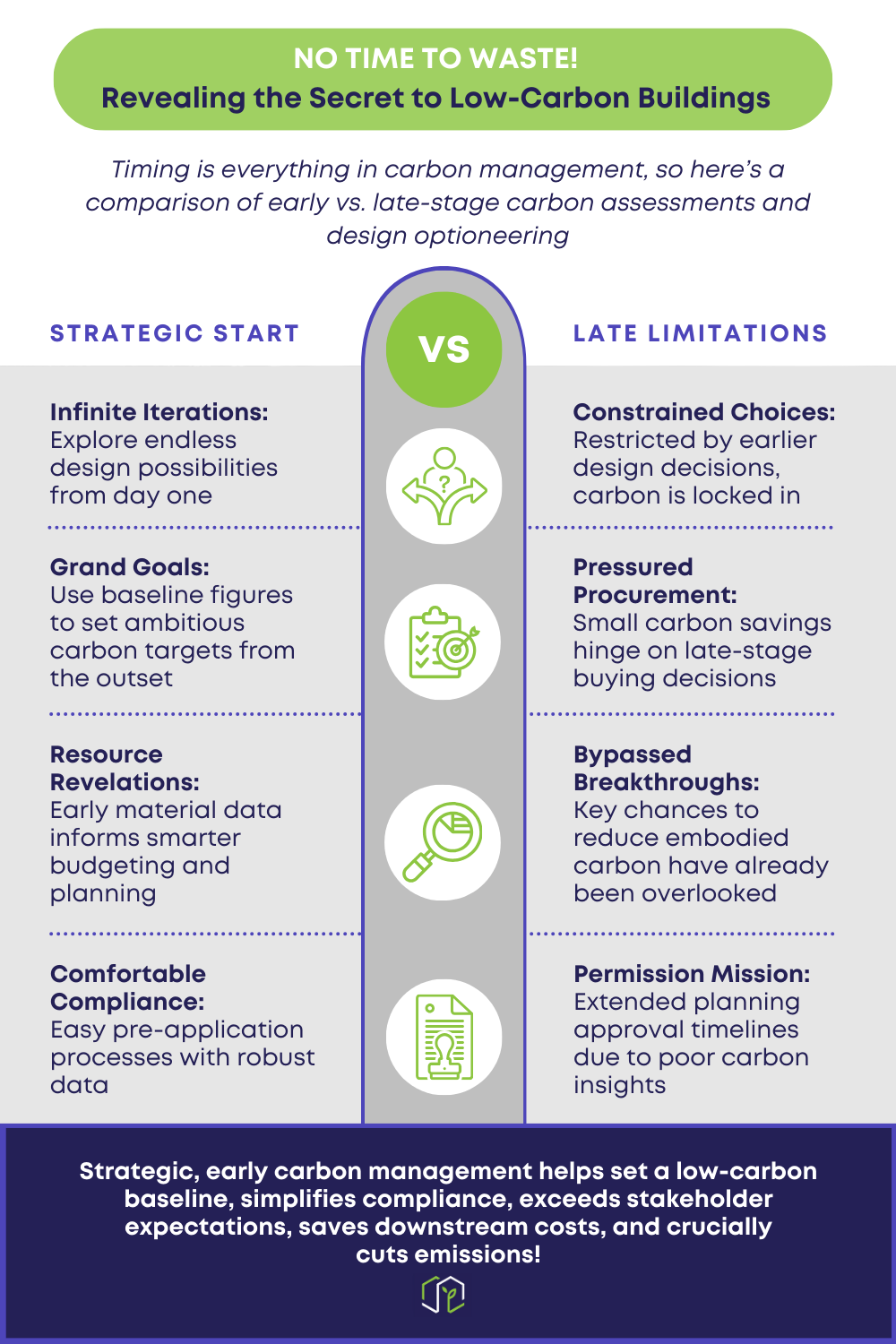The Secret to a Sustainable Building
Read Time 4 mins | Written by: Alex Bantock
Measuring and managing carbon early in the design process is crucial for achieving carbon-efficient buildings. Unlike the limitations of late-stage assessments, a strategic start allows for setting low-carbon baselines, streamlines compliance, exceeds stakeholder expectations, saves on costs, and significantly cuts emissions.
The Secret to Carbon-Efficient Buildings: An Early Start!
The secret to creating a carbon-efficient, as-built building is not shrouded in complex jargon or inaccessible technology. It's all about timing, and starting early is the key.
Although it may seem straightforward, the early consideration of carbon is far from standard practice within the Architecture, Engineering, and Construction (AEC) sector. And this oversight is not just a missed opportunity, but a detriment to our environment! By waiting until the late technical design stages to perform the first carbon assessment, the industry habitually bypasses substantial carbon reduction opportunities. This results in buildings with unnecessarily high carbon impacts — a significant issue given our perilously low carbon budget.
It's time to tighten up the purse strings!

Strategic Starts vs. Late Limitations
When you delay carbon assessments and optioneering to the technical design stages, you will continually face late-stage limitations and fall victim to constrained carbon reduction and redesign choices. Such limitations are the result of major carbon reduction opportunities (which are only present in early design) being missed, and they put all of the pressure on the procurement of sustainable materials. Moreover, this approach can lead to extended planning approval timelines due to inadequate carbon insights and therefore delay projects significantly.
In contrast, a strategic start opens the door to infinite iterations of design possibilities, allowing teams to choose the lowest-carbon design that still meets all of the functional requirements of the project. Teams can then set ambitious carbon targets from the outset and have baseline figures to constantly refer back to. Early consideration of materials and building systems also informs smarter budgeting and planning, enabling more streamlined stakeholder decision-making. In addition, integrating carbon assessments and optioneering into early design paves the way for comfortable compliance by satisfying pre-application carbon requirements, something that planning authorities are increasingly adopting.
Get Early-Stage Assessments in Minutes!
Integrating Whole Life Carbon Assessments and Design Optioneering
Therefore, integrating whole life carbon assessments and design optioneering into the early stages of design, especially during the conceptual phase, is crucial. This period is when design choices are most fluid and significant emissions can be avoided, thus simplifying downstream design processes.
Starting early with carbon management allows teams to:
-
Set a Low-Carbon Baseline: Establishing a low-carbon baseline at the beginning of a project ensures that all subsequent design decisions support a carbon-efficient outcome.
-
Simpler Planning Compliance: Early carbon management streamlines the compliance process, making it far less cumbersome.
-
Exceed Stakeholder Expectations: By setting ambitious carbon reduction targets based on your baseline impacts, you not only meet but exceed the expectations of stakeholders who are increasingly demanding sustainable buildings.
-
Save on Downstream Costs: Design revisions can be costly. An early start reduces the need for significant changes later, saving on downstream design revision costs.
-
Significant Emission Reductions: Most importantly, early carbon management cuts significant embodied carbon emissions, contributing to the global effort to combat climate change.
There's No Time to Waste
As we face the urgency of the climate crisis, the AEC industry must adopt a proactive approach to carbon management. The next time a project is initiated, remember that there's no time to waste. Early carbon management helps set a low-carbon baseline, simplifies compliance, exceeds stakeholder expectations, saves downstream costs, and crucially cuts emissions.
Adopting this approach isn't just about building better; it's about building right. For the sake of our environment, our communities, and our future, let's make the strategic start the new best practice!
We'd love to hear from you!

